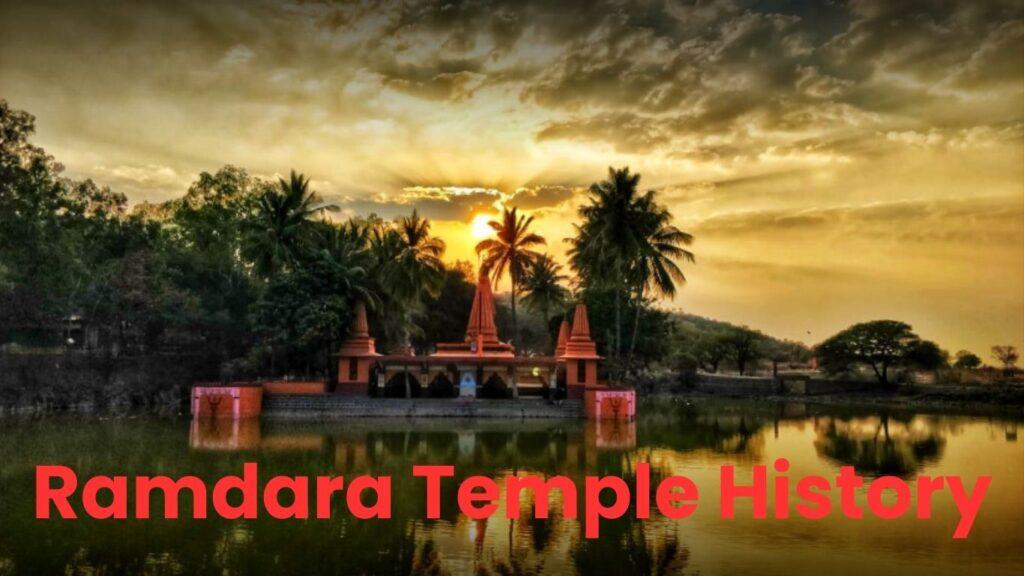Ramdara temple History was built in the ancient ruins around 1970. Actually this temple is exclusively of Lord Shiva but you will be surprised to know that this temple is popular for the idols of Lord Ram, Laxman and Mata Sita.
This temple has very interesting history and facts which we will explore further.
you will read this article carefully only then your society will understand the history of the temple.
Ramdara Temple History

The origin of the Ramdara Temple is shrouded in centuries-old mythological stories and folktales.
According to popular belief, the temple was constructed on sacred land where Lord Vishnu’s seventh avatar, Lord Rama, rested during his exile in the jungles of Bharat.
The name “Ramdara” is derived from the amalgamation of “Ram” (referring to Lord Rama) and “Dara” (meaning a place of rest), symbolizing the divine resting place.
24 Best Place For Solo Travel In India
Architectural Grandeur
The architectural splendor of the Ramdara Temple is a captivating blend of diverse historical influences.
Its construction showcases a harmonious fusion of Hindu and Islamic architectural styles, reflecting the cultural richness embedded in different epochs of Indian history.
The meticulous craftsmanship is evident in intricately carved corridors, adorned columns, and the unique amalgamation of domes and spires, a testament to the skilled artisans who contributed to its creation.
Why Travelling Is Important For Youth
Historical Significance
The Ramdara Temple has witnessed significant historical events throughout its existence.
It has served as a gathering place for spiritual and social activities, attracting devotees, pilgrims, and scholars from distant places.
Over the centuries, it has evolved into a center for religious discourse, cultural celebrations, and artistic exhibitions, fostering dialogue and unity among diverse communities.
Legends and Miracles
The temple is steeped in mythological narratives and miraculous occurrences that have deepened the reverence among its devotees.
A popular legend associated with the temple narrates the miraculous emergence of a natural spring, believed to possess purifying properties.
Devotees attribute healing and spiritual blessings to the sacred waters, reinforcing their devotion to the temple.
Preservation and Restoration
The historical and cultural significance of the Ramdara Temple has been safeguarded by dedicated custodians and philanthropists.
Their efforts ensure the temple’s structural integrity and preserve it as a sacred heritage for future generations.
The temple’s architectural magnificence and its sacred legacy are carefully maintained, contributing to the cultural legacy of India.
Festivals and Celebrations
Ramdara Temple is renowned for its vibrant festivals and celebrations, drawing large crowds of devotees.
The most significant among them is Ram Navami, commemorating the birth of Lord Rama.
Elaborate processions, devotional singing, and religious rituals characterize these festivities, creating a spiritually charged atmosphere and enhancing the sense of devotion.
Conservation and Tourism
In recent years, concerted efforts have been made to conserve and promote the Ramdara Temple as a significant cultural and spiritual destination.
The temple has become a magnet for tourists and scholars exploring India’s spiritual and historical realms.
With meticulous conservation practices and improved visitor facilities, the temple offers a transformative experience for pilgrims and tourists alike.
In Conclusion
Ramdara Temple stands tall as a living testament to India’s rich spiritual and cultural heritage.
Its ancient origins, architectural grandeur, and divine aura make it a mesmerizing destination for pilgrims and tourists alike.
As visitors step into the sacred precincts of Ramdara Temple, they leave with an indelible imprint on their hearts and minds, immersed in the profound history, spirituality, and devotion that characterize this revered site.
FAQs
1. What is the historical significance of Ramdara Temple?
Ramdara Temple holds immense historical importance as it is believed to be the place where Lord Rama, the seventh avatar of Lord Vishnu, rested during his exile in the jungles of Bharat.
2. How did the temple get its name, “Ramdara”?
The name “Ramdara” is derived from “Ram” (referring to Lord Rama) and “Dara” (meaning a place of rest), symbolizing the divine resting place associated with Lord Rama.
3. Can you elaborate on the architectural style of Ramdara Temple?
The temple showcases a harmonious blend of Hindu and Islamic architectural styles. Its design features intricately carved corridors, adorned columns, and a unique fusion of domes and spires, reflecting the craftsmanship of different historical periods.
4. Are there any specific historical events associated with Ramdara Temple?
Over the centuries, Ramdara Temple has been a center for spiritual and social activities, attracting devotees, pilgrims, and scholars. It has witnessed religious discourses, cultural celebrations, and artistic exhibitions, contributing to its historical significance.
5. Are there any legends or miraculous stories related to the temple?
Yes, the temple is associated with mythological narratives and miraculous events. One popular legend tells of a natural spring that emerged miraculously, believed to have purifying properties and attracting devotees seeking healing and blessings.

1 thought on “Ramdara Temple History: A Spiritual Journey Through Time”